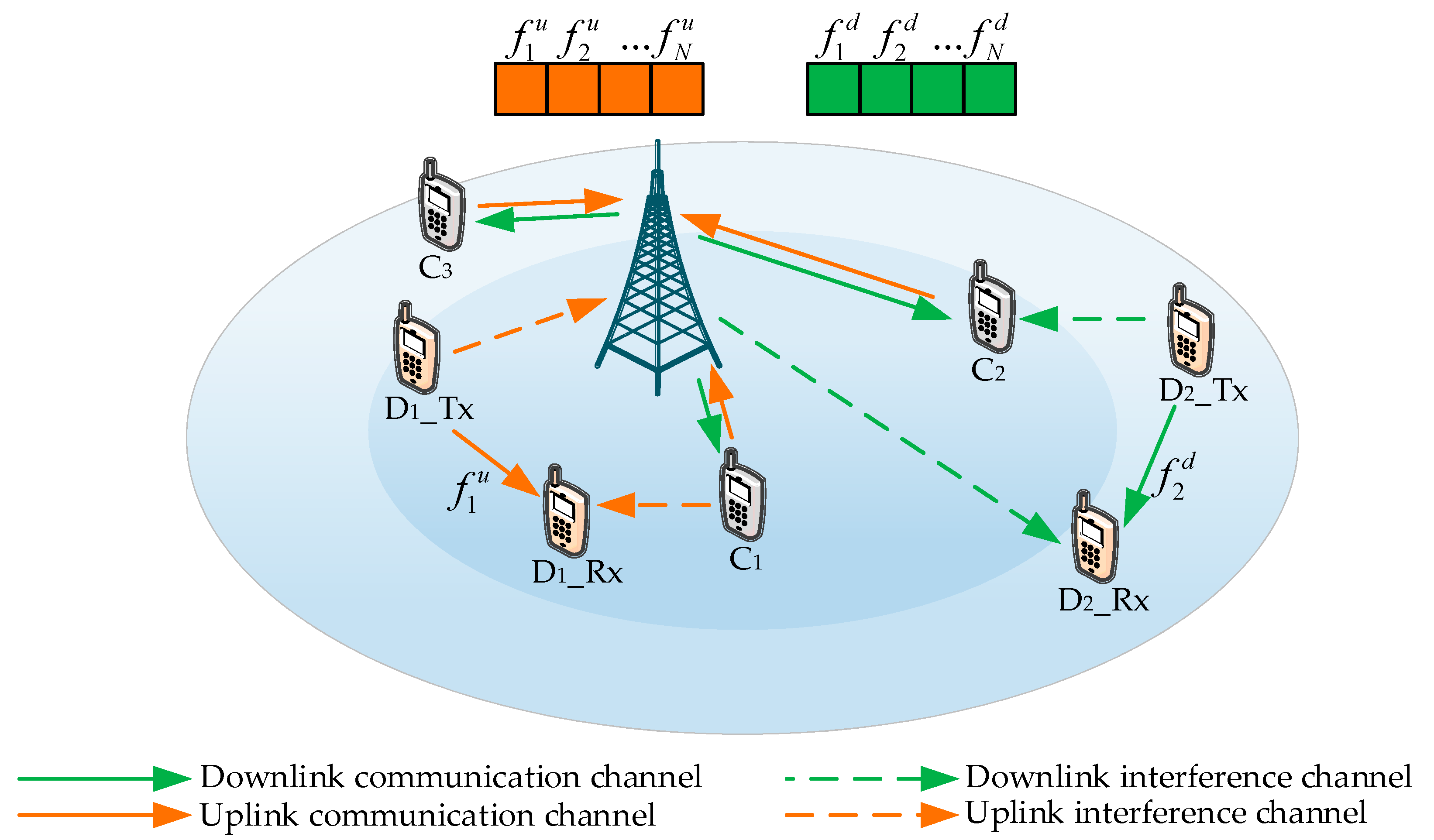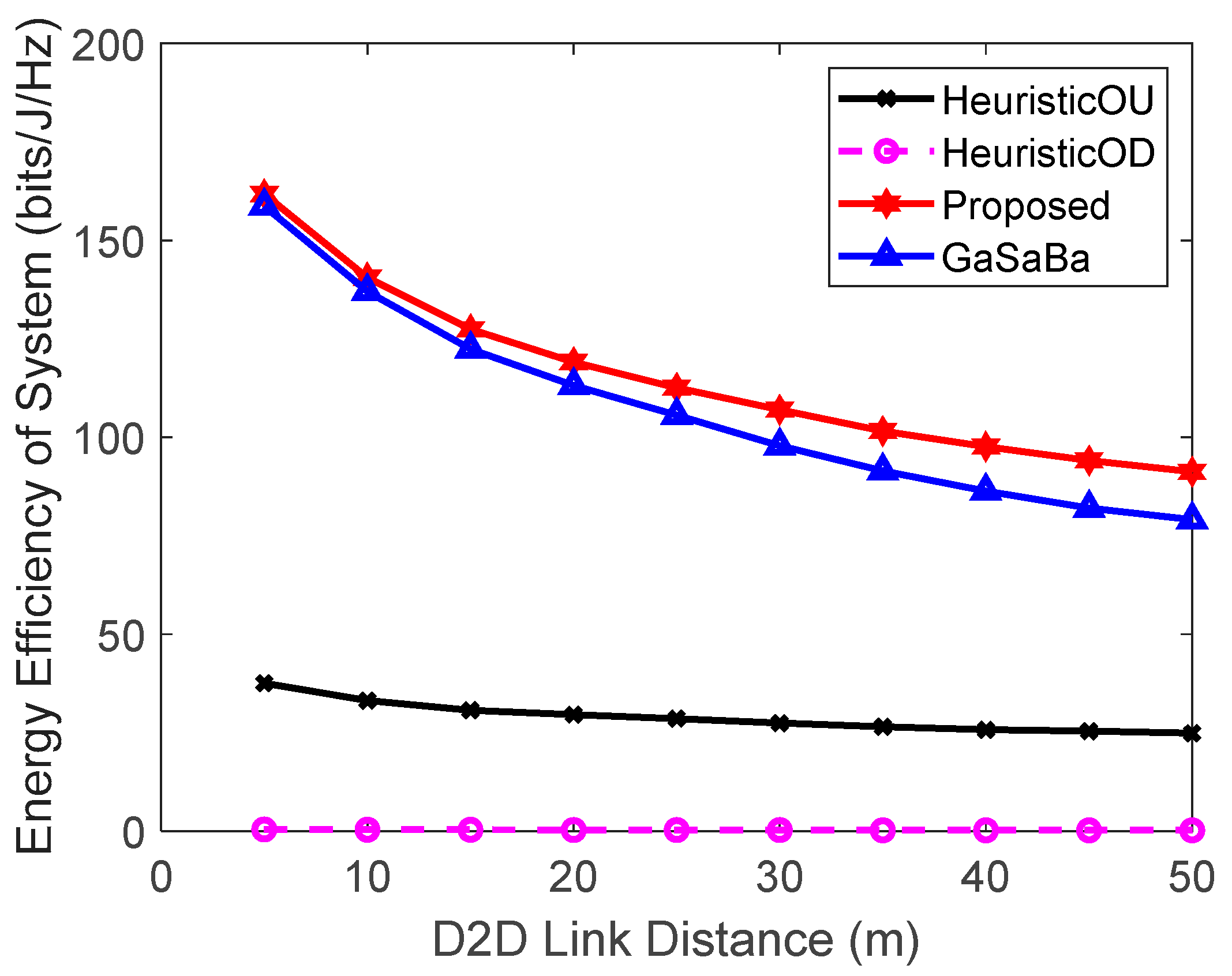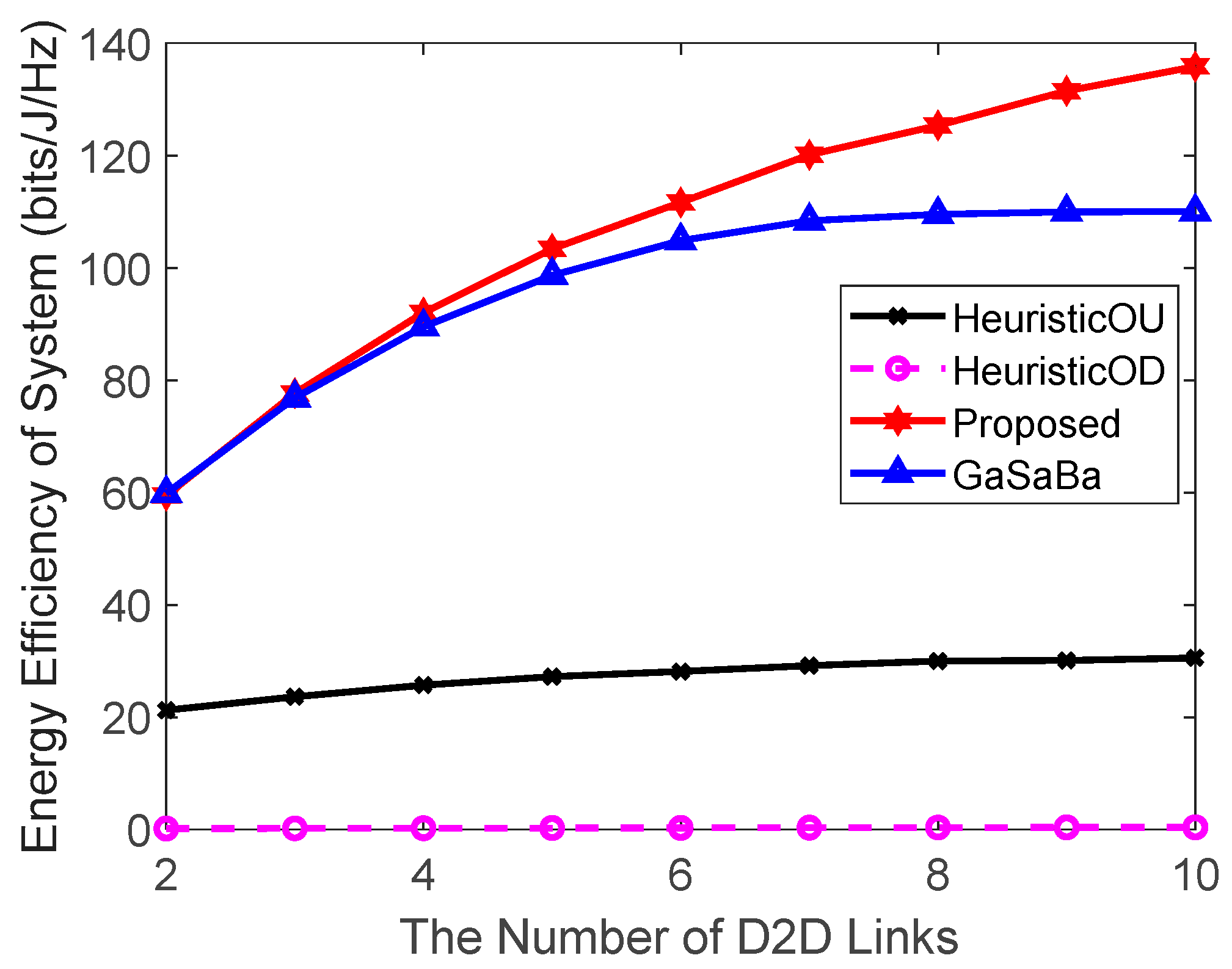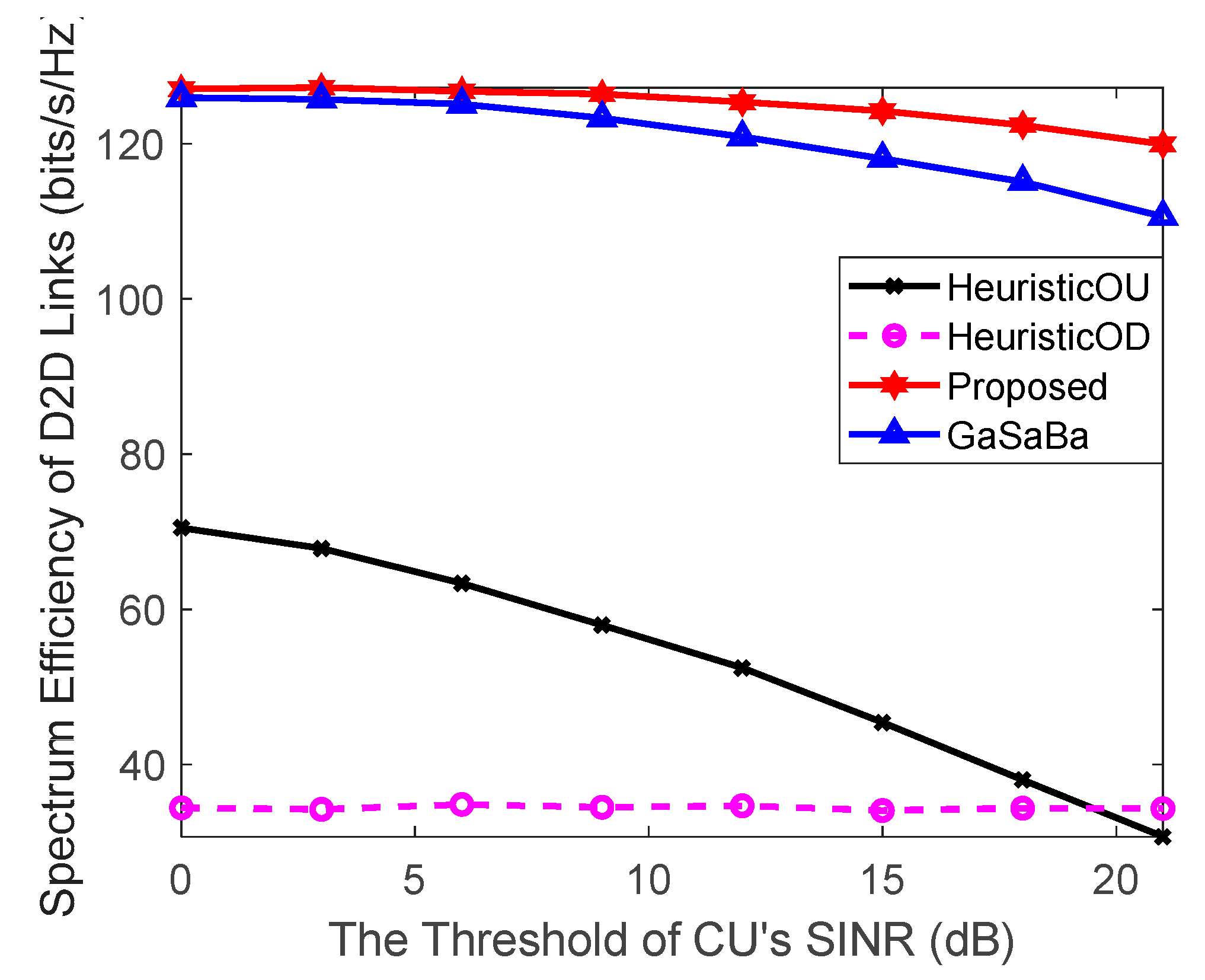A Two-Layer, Energy-Efficient Approach for Joint Power Control and Uplink–Downlink Channel Allocation in D2D Communication
Abstract
1. Introduction
- This study derived a problem formulation for optimizing the achievable EE of D2D pairs under uplink–downlink resources reuse, transmission power, and QoS constraints. The formulation obtained was a mixed-integer nonlinear programming (MINLP) problem, which is generally an unsolved non-deterministic polynomial-time hardness (NP-hard) problem within polynomial time [31,34]. To make it tractable to solve, the original problem was transformed into two sub-problems.
- One main focus of this study was to derive a closed-form expression of power allocation for maximizing the EE of an individual D2D pair while satisfying the QoS of the CUs and D2D pairs. Taking into account reusing uplink–downlink resources, we modeled the power allocation problem as an equivalent convex optimization. The optimal transmission power was further obtained based on the Lambert W function [35].
- Finally, based on the Kuhn–Munkres [36] algorithm, a channel allocation scheme was designed to optimize the overall EE of D2D pairs through the power control results. The simulation results verified the theoretical analysis and demonstrated that the proposed algorithm obtained remarkable EE performance gains and performed better than existing algorithms.
2. System Model and Problem Formulation
2.1. System Model
2.2. Problem Formulation
3. Resource Allocation Algorithm for Maximizing EE
3.1. Power Control
- 1.
- When is established, we express the optimal solution of as:
- 2.
- When is established, we express the optimal solution of as:
- 3.
- When is established, we prohibit the uplink channel resource admissible set of from including the corresponding D2D pair .
- 1.
- When is established, we express the optimal solution of as:
- 2.
- When is established, we express the optimal solution of as:
- 3.
- When is established, we prohibit the downlink channel resource admissible set of from including the corresponding D2D pair .
- If , i.e., the minimum transmission power limit of is less than 0, this cannot meet the minimum SINR requirements of the CUs. The corresponding D2D pair is prevented from reusing the uplink channel resource of .
- If , i.e., the minimum transmission power limit of BS is less than 0, this cannot meet the minimum SINR requirement of the CUs. Similar to the previous category, the corresponding D2D pair is prevented from reusing the downlink channel resource of .
- If , i.e., the minimum transmission power limit of is higher than the maximum limit, to meet the QoS requirements of the CUs within the maximum transmission power, the corresponding D2D pair is prevented from reusing the uplink channel resource of .
- If , i.e., the minimum transmission power limit of BS is higher than the maximum limit, the corresponding D2D pair is prevented from reusing the downlink channel resource of , similar to the last category.
- If , i.e., the minimum transmission power limit of D2D pair reusing uplink channel is higher than the maximum limit, the optimization process must be performed under the requirements of the minimum SINR and the maximum transmission power of the D2D pair . Otherwise, the optimization results will be meaningless. Therefore, the corresponding D2D pair is prevented from reusing the uplink channel resource of .
- If , i.e., the minimum transmission power limit of D2D pair reusing downlink channel is higher than the maximum limit, the corresponding D2D pair is prevented from reusing the downlink channel resource of , similar to the previous category.
3.2. Channel Allocation
| Algorithm 1: Resource Allocation Algorithm That Combines the Uplink–Downlink Resources to Maximize Energy Efficiency |
| Step 1: Initialize |
| 1: ; |
| Step 2: Power Control |
| 2: for , do |
| 3: Calculate the minimum transmission power limit of the CUs, D2D pairs, and BS according to Constraints (19), (20), (29), and (30); |
| 4: Calculate the transmission power of the CUs and BS based on Equations (21) and (31); |
| 5: Calculate the optimal transmission power of the D2D pairs reusing the uplink or downlink channel resources based on Equations (27), (28), (34), and (35); |
| 6: if , , or then |
| 7: Prevent the D2D pair in the admissible set from reusing the uplink channel resource of ; |
| 8: end if |
| 9: if , , or then |
| 10: Prevent the D2D pair in the admissible set from reusing the downlink channel resource of ; |
| 11: end if |
| 12: end for |
| Step 3: Channel Allocation |
| 13: Obtain the channel allocation set based on the Kuhn–Munkres algorithm. |
4. Numerical Results
4.1. Simulation Design
- Heuristic algorithm reusing the uplink spectrum resources [24]: The basic principle of this algorithm is that the BS preferentially selects the cellular link with a high channel gain and the D2D communication link with the least interference to reuse the same channel. The algorithm consists of access control based on interference control, fixed power allocation, and heuristic channel allocation. This algorithm is feasible and straightforward, and the interference caused by the D2D link to the cellular link is small. However, the power between the D2D pairs and CUs are not considered for coordination; meanwhile, the algorithm is based on the assumption that only uplink resources can be shared. Therefore, the performance of D2D communication is not sufficiently improved. The algorithm is labeled “HeuristicOU.”
- Heuristic algorithm reusing the downlink spectrum resources [24]: The principle of this algorithm is similar to the “HeuristicOU” algorithm, where the difference lies in the assumption that only downlink resources can be shared. The algorithm is labeled “HeuristicOD.”
- Stable matching algorithm reusing the uplink spectrum resources [30]: This algorithm allocates optimal transmission power to the D2D pairs. Then, the channel gain ratio of the communication link and the interference link is defined as the sequence value of the user-matching preference. The Gale–Shapley algorithm is utilized to establish the preferences of each user equipment and complete the matching of the D2D pairs and CUs. This algorithm effectively improves the EE of the D2D pairs. However, it does not jointly reuse the uplink and downlink spectrum resources, and its channel-matching algorithm only obtains stable matching results. Therefore, the EE of the D2D pairs in the network could still be further improved. The algorithm is labeled “GaSaBa.”
4.2. Results and Discussions
4.2.1. Effect of the D2D Transmission Distance on the System Performance
4.2.2. Effect of Number of D2D Links on the System Performance
4.2.3. Effect of Threshold of the CUs SINR on System Performance
5. Conclusions
Author Contributions
Funding
Conflicts of Interest
Appendix A
| Notations | Variables and Parameters |
|---|---|
| CUs | |
| D2D pairs | |
| uplink resource of | |
| downlink resource of | |
| D2D transmitter of | |
| D2D receiver of | |
| interference channel gain from to the D2D receiver of | |
| pathloss constant | |
| multipath fading parameter from to the D2D receiver of | |
| shadow gain from to the receiver of | |
| distance from to the receiver of | |
| path loss factor | |
| channel gain of | |
| channel gain between and BS | |
| interference channel gain from the D2D transmitter of to the BS | |
| interference channel gain from the BS to the D2D receiver of | |
| interference channel gain from the D2D transmitter of to | |
| received signal at the BS | |
| transmission power of | |
| transmission power of reusing an uplink channel | |
| transmission signal of | |
| transmission signal of | |
| noise in each channel | |
| binary variable that the uplink resource of allocated to | |
| SINR at the BS | |
| received signal at the D2D pair reusing an uplink channel | |
| SINR at the receiver of D2D pair reusing an uplink channel | |
| SINR of the receiver of | |
| SINR at the receiver of the D2D pair reusing a downlink channel | |
| transmission power of the BS | |
| transmission power of the reusing a downlink channel | |
| binary variable that the downlink resource of allocated to | |
| SE of the reusing an uplink channel of | |
| SE of the reusing a downlink channel of | |
| equipment circuit loss | |
| total EE of the D2D pairs | |
| CU’s maximum transmission power | |
| D2D’s maximum transmission power | |
| BS’s maximum transmission power | |
| CU’s SINR thresholds | |
| D2D’s SINR thresholds | |
| D2D’s maximum transmission distance |
Appendix B
References
- Ben-Daya, M.; Hassini, E.; Bahroun, Z. Internet of things and supply chain management: A literature review. Int. J. Prod. Res. 2019, 57, 4719–4742. [Google Scholar] [CrossRef]
- Yu, B.; Zhang, X.; Palmieri, F.; Creignou, E.; You, I. A deep learning approach for maximum activity links in D2D communications. Sensors 2019, 19, 2941. [Google Scholar] [CrossRef]
- Nitti, M.; Stelea, G.A.; Popescu, V.; Fadda, M. When social networks meet D2D communications: A survey. Sensors 2019, 19, 396. [Google Scholar] [CrossRef]
- Chang, W.; Teng, J.-C. Energy efficient relay matching with bottleneck effect elimination power adjusting for full-duplex relay assisted D2D networks using mmWave technology. IEEE Access 2018, 6, 3300–3309. [Google Scholar] [CrossRef]
- Gandotra, P.; Jha, R.K.; Jain, S. Sector-based radio resource allocation (SBRRA) algorithm for better quality of service and experience in device-to-device (D2D) communication. IEEE Trans. Veh. Technol. 2018, 67, 5750–5765. [Google Scholar] [CrossRef]
- Fodor, G.; Dahlman, E.; Mildh, G.; Parkvall, S.; Reider, N.; Miklós, G.; Turányi, Z. Design aspects of network assisted device-to-device communications. IEEE Commun. Mag. 2012, 50, 170–177. [Google Scholar] [CrossRef]
- Liu, J.; Kawamoto, Y.; Nishiyama, H.; Kato, N.; Kadowaki, N. Device-to-device communications achieve efficient load balancing in LTE-advanced networks. IEEE Wirel. Commun. 2014, 21, 57–65. [Google Scholar] [CrossRef]
- Li, R.; Hong, P.; Xue, K.; Zhang, M.; Yang, T. Energy-Efficient Resource Allocation for High-Rate Underlay D2D Communications with Statistical CSI: A One-to-Many Strategy. IEEE Trans. Veh. Technol. 2020, 69, 4006–4018. [Google Scholar] [CrossRef]
- Lei, L.; Kuang, Y.; Cheng, N.; Shen, X.S.; Zhong, Z.; Lin, C. Delay-optimal dynamic mode selection and resource allocation in device-to-device communications—Part I: Optimal policy. IEEE Trans. Veh. Technol. 2015, 65, 3474–3490. [Google Scholar] [CrossRef]
- Liu, J.; Nishiyama, H.; Kato, N.; Guo, J. On the outage probability of device-to-device-communication-enabled multichannel cellular networks: An RSS-threshold-based perspective. IEEE J. Sel. Areas Commun. 2015, 34, 163–175. [Google Scholar] [CrossRef]
- Liu, J.; Kato, N.; Ma, J.; Kadowaki, N. Device-to-device communication in LTE-advanced networks: A survey. IEEE Commun. Surv. Tutor. 2014, 17, 1923–1940. [Google Scholar] [CrossRef]
- Golrezaei, N.; Mansourifard, P.; Molisch, A.F.; Dimakis, A.G. Base-station assisted device-to-device communications for high-throughput wireless video networks. IEEE Trans. Wirel. Commun. 2014, 13, 3665–3676. [Google Scholar] [CrossRef]
- Kai, C.; Li, H.; Xu, L.; Li, Y.; Jiang, T. Energy-efficient device-to-device communications for green smart cities. IEEE Trans. Ind. Inform. 2018, 14, 1542–1551. [Google Scholar] [CrossRef]
- Jiang, L.; Tian, H.; Xing, Z.; Wang, K.; Zhang, K.; Maharjan, S.; Gjessing, S.; Zhang, Y. Social-aware energy harvesting device-to-device communications in 5G networks. IEEE Wirel. Commun. 2016, 23, 20–27. [Google Scholar] [CrossRef]
- Chen, Y.; Xie, G.; Li, R. Reducing energy consumption with cost budget using available budget preassignment in heterogeneous cloud computing systems. IEEE Access 2018, 6, 20572–20583. [Google Scholar] [CrossRef]
- Xie, G.; Jiang, J.; Liu, Y.; Li, R.; Li, K. Minimizing energy consumption of real-time parallel applications using downward and upward approaches on heterogeneous systems. IEEE Trans. Ind. Inform. 2017, 13, 1068–1078. [Google Scholar] [CrossRef]
- Zhang, Z.; Wang, L.; Zhang, J. Energy efficiency of D2D multi-user cooperation. Sensors 2017, 17, 697. [Google Scholar] [CrossRef]
- Zhou, L.; Wu, D.; Chen, J.; Dong, Z. Greening the smart cities: Energy-efficient massive content delivery via D2D communications. IEEE Trans. Ind. Inform. 2017, 14, 1626–1634. [Google Scholar] [CrossRef]
- Wang, F.; Xu, C.; Song, L.; Han, Z. Energy-efficient resource allocation for device-to-device underlay communication. IEEE Trans. Wirel. Commun. 2014, 14, 2082–2092. [Google Scholar] [CrossRef]
- Chen, B.; Yang, C.; Wang, G. High-throughput opportunistic cooperative device-to-device communications with caching. IEEE Trans. Veh. Technol. 2017, 66, 7527–7539. [Google Scholar] [CrossRef]
- Jiang, Y.; Liu, Q.; Zheng, F.; Gao, X.; You, X. Energy-efficient joint resource allocation and power control for D2D communications. IEEE Trans. Veh. Technol. 2015, 65, 6119–6127. [Google Scholar] [CrossRef]
- Wei, L.; Hu, R.Q.; Qian, Y.; Wu, G. Energy efficiency and spectrum efficiency of multihop device-to-device communications underlaying cellular networks. IEEE Trans. Veh. Technol. 2015, 65, 367–380. [Google Scholar] [CrossRef]
- Li, Y.; Zhang, Z.; Wang, H.; Yang, Q. SERS: Social-aware energy-efficient relay selection in D2D communications. IEEE Trans. Veh. Technol. 2018, 67, 5331–5345. [Google Scholar] [CrossRef]
- Zulhasnine, M.; Huang, C.; Srinivasan, A. Efficient resource allocation for device-to-device communication underlaying LTE network. In Proceedings of the 2010 IEEE 6th International Conference on Wireless and Mobile Computing, Networking and Communications, Niagara Falls, ON, Canada, 11 October 2010; pp. 368–375. [Google Scholar]
- Li, Y.; Jin, D.; Yuan, J.; Han, Z. Coalitional games for resource allocation in the device-to-device uplink underlaying cellular networks. IEEE Trans. Wirel. Commun. 2014, 13, 3965–3977. [Google Scholar] [CrossRef]
- Hoang, T.D.; Le, L.B.; Le-Ngoc, T. Resource allocation for D2D communication underlaid cellular networks using graph-based approach. IEEE Trans. Wirel. Commun. 2016, 15, 7099–7113. [Google Scholar] [CrossRef]
- Kaufman, B.; Lilleberg, J.; Aazhang, B. Spectrum sharing scheme between cellular users and ad-hoc device-to-device users. IEEE Trans. Wirel. Commun. 2013, 12, 1038–1049. [Google Scholar] [CrossRef]
- Wang, Q.; Wang, W.; Jin, S.; Zhu, H.; Zhang, N.T. Quality-optimized joint source selection and power control for wireless multimedia D2D communication using Stackelberg game. IEEE Trans. Veh. Technol. 2014, 64, 3755–3769. [Google Scholar] [CrossRef]
- Rahman, M.A.; Lee, Y.; Koo, I. Energy-efficient power allocation and relay selection schemes for relay-assisted d2d communications in 5g wireless networks. Sensors 2018, 18, 2865. [Google Scholar] [CrossRef]
- Liu, S.; Wu, Y.; Li, L.; Liu, X.; Xu, W. A two-stage energy-efficient approach for joint power control and channel allocation in D2D communication. IEEE Access 2019, 7, 16940–16951. [Google Scholar] [CrossRef]
- Zhou, Z.; Ota, K.; Dong, M.; Xu, C. Energy-efficient matching for resource allocation in D2D enabled cellular networks. IEEE Trans. Veh. Technol. 2016, 66, 5256–5268. [Google Scholar] [CrossRef]
- Zhou, Z.; Ma, G.; Dong, M.; Ota, K.; Xu, C.; Jia, Y. Iterative energy-efficient stable matching approach for context-aware resource allocation in D2D communications. IEEE Access 2016, 4, 6181–6196. [Google Scholar] [CrossRef]
- Zhang, R.; Cheng, X.; Yang, L.; Jiao, B. Interference graph-based resource allocation (InGRA) for D2D communications underlaying cellular networks. IEEE Trans. Veh. Technol. 2014, 64, 3844–3850. [Google Scholar] [CrossRef]
- Phunchongharn, P.; Hossain, E.; Kim, D.I. Resource allocation for device-to-device communications underlaying LTE-advanced networks. IEEE Wirel. Commun. 2013, 20, 91–100. [Google Scholar] [CrossRef]
- Corless, R.M.; Gonnet, G.H.; Hare, D.E.; Jeffrey, D.J.; Knuth, D.E. On the Lambert W function. Adv. Comput. Math. 1996, 5, 329–359. [Google Scholar] [CrossRef]
- Edmonds, J.; Karp, R.M. Theoretical improvements in algorithmic efficiency for network flow problems. J. ACM (JACM) 1972, 19, 248–264. [Google Scholar] [CrossRef]
- Kwon, H.; Birdsall, T. Channel capacity in bits per joule. IEEE J. Ocean. Eng. 1986, 11, 97–99. [Google Scholar] [CrossRef]







| Parameters | Value |
|---|---|
| Cell radius | 250 m |
| Noise power spectral density | −174 dBm/Hz |
| CU’s maximum transmission power | 24 dBm |
| D2D’s maximum transmission power | 21 dBm |
| BS’s maximum transmission power | 46 dBm |
| CU’s SINR thresholds | [0,25] dB |
| D2D’s SINR thresholds | [0,25] dB |
| D2D’s maximum transmission distance | 25, [5, 10, …, 50] m |
| Number of CUs | 10 |
| Number of D2D pairs | 6, 2–10 |
| Multipath fading parameters (mean of exponential distribution) | 1 |
| Shadow fading (standard deviation of log-normal distribution) | 8 dB |
| Path loss factor | 4 |
| Equipment circuit loss | 50 mW |
© 2020 by the authors. Licensee MDPI, Basel, Switzerland. This article is an open access article distributed under the terms and conditions of the Creative Commons Attribution (CC BY) license (http://creativecommons.org/licenses/by/4.0/).
Share and Cite
Zhou, L.; Wu, Y.; Yu, H. A Two-Layer, Energy-Efficient Approach for Joint Power Control and Uplink–Downlink Channel Allocation in D2D Communication. Sensors 2020, 20, 3285. https://doi.org/10.3390/s20113285
Zhou L, Wu Y, Yu H. A Two-Layer, Energy-Efficient Approach for Joint Power Control and Uplink–Downlink Channel Allocation in D2D Communication. Sensors. 2020; 20(11):3285. https://doi.org/10.3390/s20113285
Chicago/Turabian StyleZhou, Li, Yucheng Wu, and Haifei Yu. 2020. "A Two-Layer, Energy-Efficient Approach for Joint Power Control and Uplink–Downlink Channel Allocation in D2D Communication" Sensors 20, no. 11: 3285. https://doi.org/10.3390/s20113285
APA StyleZhou, L., Wu, Y., & Yu, H. (2020). A Two-Layer, Energy-Efficient Approach for Joint Power Control and Uplink–Downlink Channel Allocation in D2D Communication. Sensors, 20(11), 3285. https://doi.org/10.3390/s20113285





